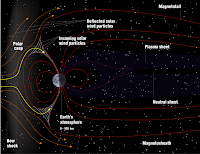 |
| Magnetosphere |
One important characteristic of the planets is their intrinsic magnetic moments which in turn give rise to magnetospheres. The presence of a magnetic field indicates that the planet is still geologically alive. In other words, magnetized planets have flows of electrically conducting material in their interiors, which generate their magnetic fields. These fields significantly change the interaction of the planet and solar wind. A magnetized planet creates a cavity in the solar wind around itself called magnetosphere, which the wind cannot penetrate. The magnetosphere can be much larger than the planet itself. In contrast, non-magnetized planets have only small magnetospheres induced by interaction of the ionosphere with the solar wind, which cannot effectively protect the planet.




